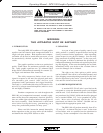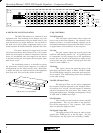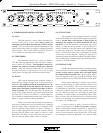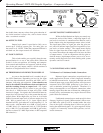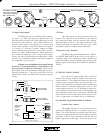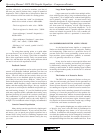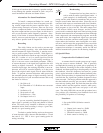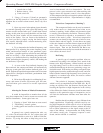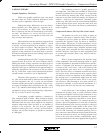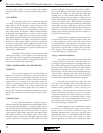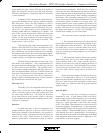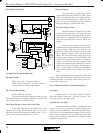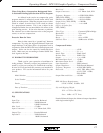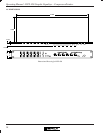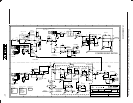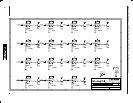
11
Operating Manual - DPX-100 Graphic Equalizer - Compressor/Limiter
9. DESIGN THEORY
Graphic Equalizers: The Basics
While most graphic equalizers look very much
the same, there are several important differences in the
circuitry used to implement various designs.
Perhaps the major differences are in the filters.
Some equalizers use a filter made of a capacitor, an in-
ductor, and a resistor, or “RLC” filter. The advantage
here is simplicity, but the real disadvantage is the induc-
tor itself. An inductor is a coil of wire with a core of
some sort. Inductors are susceptible to hum fields and
they are large and expensive.
Other equalizers use the same basic approach, but
replace the inductor with a “simulated inductor”, which
is actually a circuit comprised of an amplifier, a capaci-
tor, and a couple of resistors. This adds parts but is less
expensive than a real inductor. The problem with this
approach is that simulation is less than ideal; it produces
an inductor with high resistive loss resulting in poor curve
shape when used in a filter.
Another problem with “RLC” designs is that large
capacitors must be used for the lower frequency filters,
limiting the choice to large, expensive non-polar types or
electrolytic capacitors with poor audio performance. Also,
when this filter type is combined with a potentiometer to
adjust the equalization, the resistance of this pot affects
the “Q” of the filter so that a little equalization produces
a much broader curve than a lot of equalization.
The other filter approach is a true bandpass fil-
ter. This can be made with no inductors and more practi-
cal sized capacitors; the “Q” is easily set and remains
constant, and the parts count is reasonable. there are sev-
eral types of bandpass filters suitable for this job. Ashly
uses a “Q” enhanced Wein-bridge filter. Because it is a
symmetrical design using matched tuning components,
the “Q” is easily set and is very stable.
In designing a graphic equalizer, a selection of
filter sharpness must be made. More sharpness (higher
Q) produces less filter overlap and tighter control over an
individual band, but also causes ripple in the frequency
response when many filters are boost or cut together to
produce a flat response. We feel that the graphic
equalizer’s primary use is for “voicing” and tone control,
and have set our filter sharpness to produce a maximum
of 1dB ripple.
The summing system in a graphic equalizer is
also important. Since there are a number of filters which
combine to produce the overall response, it is important
that the filters not interact (they WILL overlap, but the
response of one filter should not modify the response of
another). Ashly uses an “interleaved” summing system
where every other filter uses the same summing amplifier
so that adjacent filters never share the same drive and
feedback signals. This allows the filters to maintain their
natural response.
Compressor/Limiters: The Need For Gain Control
The human ear excels in its ability to detect an
extremely wide range of loudness levels, from the quiet-
est whisper to roar of a jumbo jet. When we attempt to
reproduce this dynamic range, by means of amplifiers,
tape recorders, CD players, or radio transmitters, we run
into one of the fundamental limitations of these electronic
media: limited dynamic range. Amplifier dynamic range
is quite good, and is adequate for most musical program
material. However, some types of audio equipment, such
as cassette tape recorders, have a very narrow useful dy-
namic range.
What is it that compromises the dynamic range
of this equipment? The useful operating region of a piece
of audio equipment is squeezed in between noise and dis-
tortion. As program level decreases, it approaches what
is known as the “noise floor”, and if the volume of the
program material goes lower still, it is engulfed by the
noise. The noise floor, or minimum constant noise level,
will consist of hiss, hum, transistor noise, tape hiss, buzz
and whatever noises are inherent in the medium. When
the program level is considerably higher than the noise
floor, our hearing masks the noise, and it is not a prob-
lem. However, when listening to very quiet sections of a
program for example, a pause between movements of a
string quartet the noise can become very bothersome.
At the other end of the loudness spectrum, the
limitation on dynamic range is usually distortion, either
in the form of amplifier overload, tape saturation, or A to
D clipping. In most transistorized equipment, the transi-
tion from clean, undistorted operation to severe distor-
tion is very abrupt. Therefore, it is common practice to
operate a piece of equipment at a level that is somewhat
below the distortion point, leaving a margin of safety for
unexpected, transient volume peaks in the music. This
safety margin is known as headroom, and may range from
10 to 25 dB. Lowering our standard operating level to
leave ourselves some headroom helps prevent distortion,
but at the same time it moves our average program level
closer to the noise floor, thereby compromising signal-
to-noise performance. It becomes apparent that to get most



